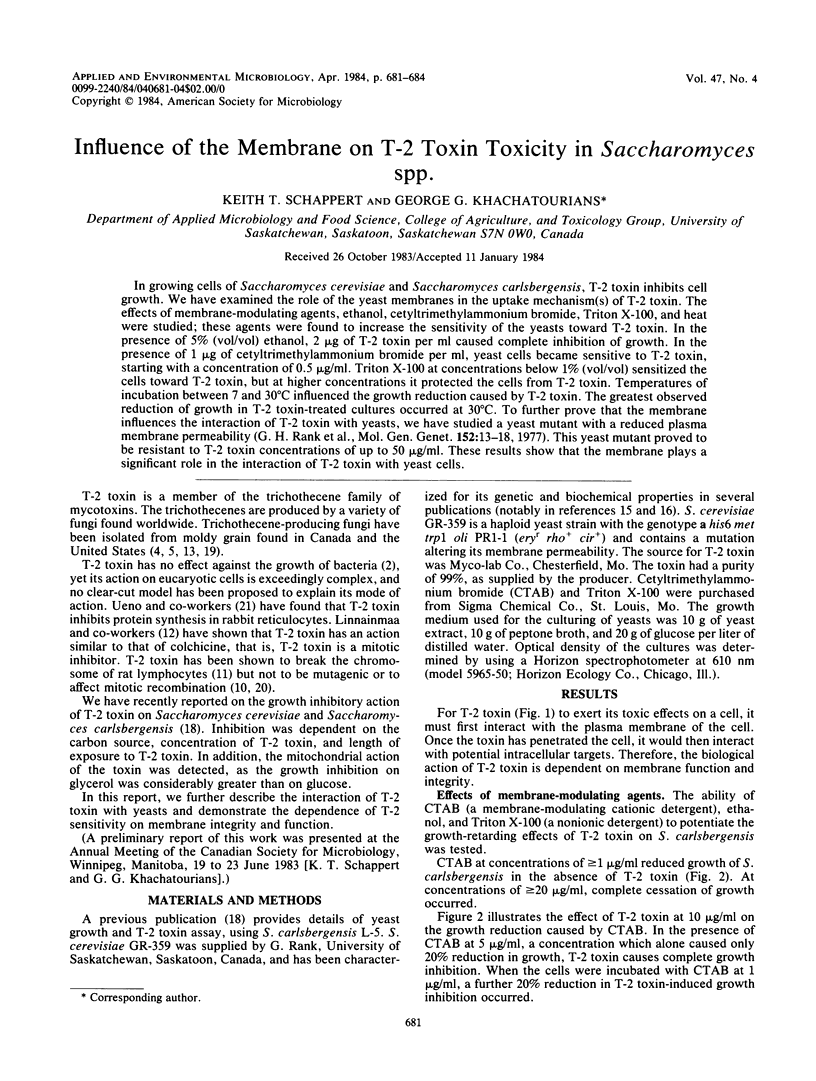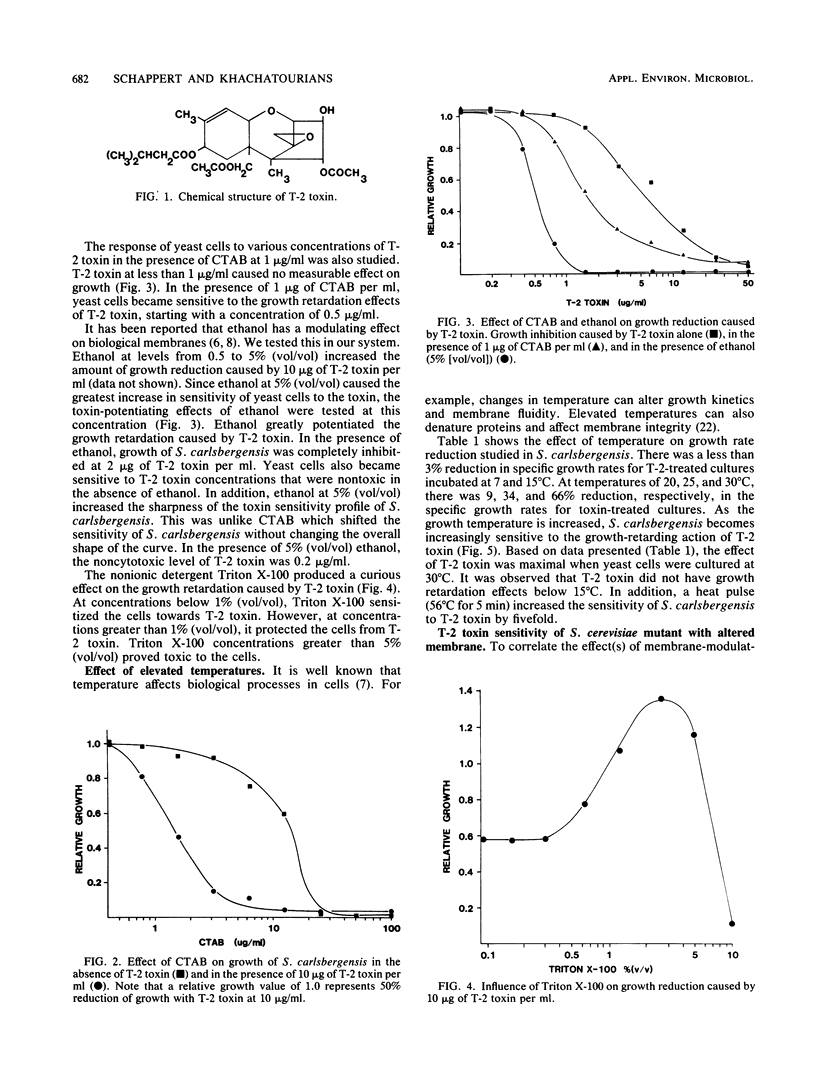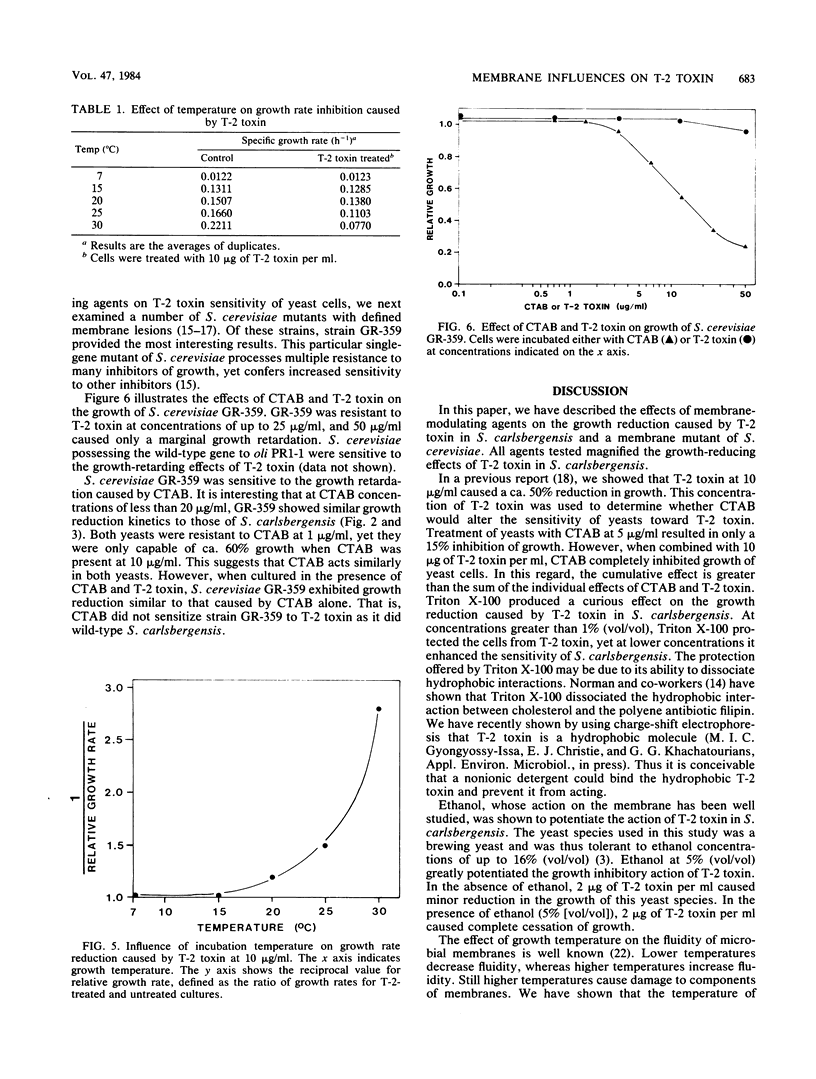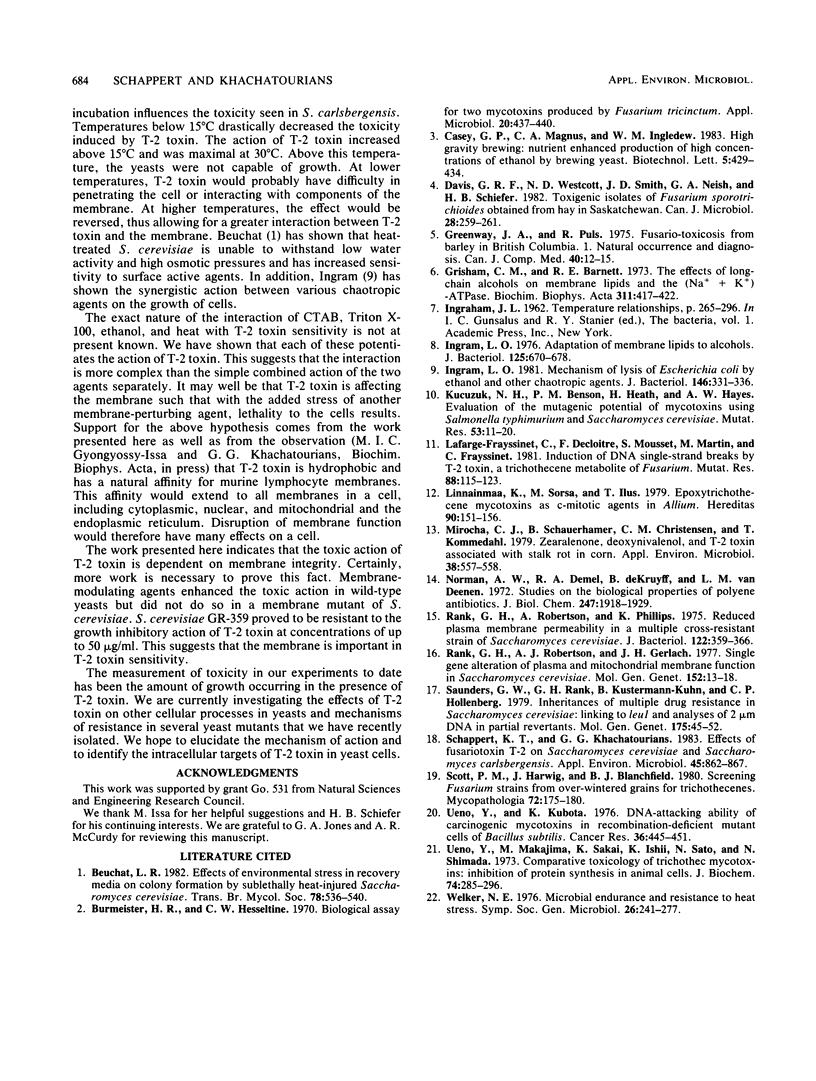Abstract
In growing cells of Saccharomyces cerevisiae and Saccharomyces carlsbergensis, T-2 toxin inhibits cell growth. We have examined the role of the yeast membranes in the uptake mechanism(s) of T-2 toxin. The effects of membrane-modulating agents, ethanol, cetyltrimethylammonium bromide, Triton X-100, and heat were studied; these agents were found to increase the sensitivity of the yeasts toward T-2 toxin. In the presence of 5% (vol/vol) ethanol, 2 micrograms of T-2 toxin per ml caused complete inhibition of growth. In the presence of 1 microgram of cetyltrimethylammonium bromide per ml, yeast cells became sensitive to T-2 toxin, starting with a concentration of 0.5 micrograms/ml. Triton X-100 at concentrations below 1% (vol/vol) sensitized the cells toward T-2 toxin, but at higher concentrations it protected the cells from T-2 toxin. Temperatures of incubation between 7 and 30 degrees C influenced the growth reduction caused by T-2 toxin. The greatest observed reduction of growth in T-2 toxin-treated cultures occurred at 30 degrees C. To further prove that the membrane influences the interaction of T-2 toxin with yeasts, we have studied a yeast mutant with a reduced plasma membrane permeability (G. H. Rank et al., Mol. Gen. Genet. 152:13-18, 1977). This yeast mutant proved to be resistant to T-2 toxin concentrations of up to 50 micrograms/ml. These results show that the membrane plays a significant role in the interaction of T-2 toxin with yeast cells.
Full text
PDF



Selected References
These references are in PubMed. This may not be the complete list of references from this article.
- Burmeister H. R., Hesseltine C. W. Biological assays for two mycotoxins produced by Fusarium tricinctum. Appl Microbiol. 1970 Sep;20(3):437–440. doi: 10.1128/am.20.3.437-440.1970. [DOI] [PMC free article] [PubMed] [Google Scholar]
- Davis G. R., Westcott N. D., Smith J. D., Neish G. A., Schiefer H. B. Toxigenic isolates of Fusarium sporotrichioides obtained from hay in Saskatchewan. Can J Microbiol. 1982 Feb;28(2):259–261. doi: 10.1139/m82-035. [DOI] [PubMed] [Google Scholar]
- Greenway J. A., Puls R. Fusariotoxicosis from barley in British Columbia. I. Natural occurrence and diagnosis. Can J Comp Med. 1976 Jan;40(1):12–15. [PMC free article] [PubMed] [Google Scholar]
- Grisham C. M., Barnett R. E. The effects of long-chain alcohols on membrane lipids and the (Na++K+)-ATPase. Biochim Biophys Acta. 1973 Jul 6;311(3):417–422. doi: 10.1016/0005-2736(73)90322-2. [DOI] [PubMed] [Google Scholar]
- Ingram L. O. Adaptation of membrane lipids to alcohols. J Bacteriol. 1976 Feb;125(2):670–678. doi: 10.1128/jb.125.2.670-678.1976. [DOI] [PMC free article] [PubMed] [Google Scholar]
- Ingram L. O. Mechanism of lysis of Escherichia coli by ethanol and other chaotropic agents. J Bacteriol. 1981 Apr;146(1):331–336. doi: 10.1128/jb.146.1.331-336.1981. [DOI] [PMC free article] [PubMed] [Google Scholar]
- Lafarge-Frayssinet C., Decloitre F., Mousset S., Martin M., Frayssinet C. Induction of DNA single-strand breaks by T2 toxin, a trichothecene metabolite of fusarium: effect on lymphoid organs and liver. Mutat Res. 1981 Feb;88(2):115–123. doi: 10.1016/0165-1218(81)90010-0. [DOI] [PubMed] [Google Scholar]
- Linnainmaa K., Sorsa M., Ilus T. Epoxytrichothecene mycotoxins as c-mitotic agents in Allium. Hereditas. 1979;90(2):151–155. doi: 10.1111/j.1601-5223.1979.tb01303.x. [DOI] [PubMed] [Google Scholar]
- Mirocha C. J., Schauerhamer B., Christensen C. M., Kommedahl T. Zearalenone, deoxynivalenol, and T-2 toxin associated with stalk rot in corn. Appl Environ Microbiol. 1979 Sep;38(3):557–558. doi: 10.1128/aem.38.3.557-558.1979. [DOI] [PMC free article] [PubMed] [Google Scholar]
- Norman A. W., Demel R. A., de Kruyff B., van Deenen L. L. Studies on the biological properties of polyene antibiotics. Evidence for the direct interaction of filipin with cholesterol. J Biol Chem. 1972 Mar 25;247(6):1918–1929. [PubMed] [Google Scholar]
- Rank G. H., Robertson A. J., Gerlach J. H. Single gene alteration of plasma and mitochondrial membrane function in Saccharomyces cerevisiae. Mol Gen Genet. 1977 Mar 28;152(1):13–18. doi: 10.1007/BF00264934. [DOI] [PubMed] [Google Scholar]
- Rank G. H., Robertson A., Phillips K. Reduced plasma membrane permeability in a multiple cross-resistant strain of Saccharomyces cerevisiae. J Bacteriol. 1975 May;122(2):359–366. doi: 10.1128/jb.122.2.359-366.1975. [DOI] [PMC free article] [PubMed] [Google Scholar]
- Saunders G. W., Rank G. H., Kustermann-Kuhn B., Hollenberg C. P. Inheritance of multiple drug resistance in Saccharomyces cerevisiae: linkage to leu1 and analyses of 2 micron DNA in partial revertants. Mol Gen Genet. 1979 Aug;175(1):45–52. doi: 10.1007/BF00267854. [DOI] [PubMed] [Google Scholar]
- Schappert K. T., Khachatourians G. G. Effects of Fusariotoxin T-2 on Saccharomyces cerevisiae and Saccharomyces carlsbergensis. Appl Environ Microbiol. 1983 Mar;45(3):862–867. doi: 10.1128/aem.45.3.862-867.1983. [DOI] [PMC free article] [PubMed] [Google Scholar]
- Scott P. M., Harwig J., Blanchfield B. J. Screening Fusarium strains isolated from overwintered Canadian grains for trichothecenes. Mycopathologia. 1980 Nov 28;72(3):175–180. doi: 10.1007/BF00572661. [DOI] [PubMed] [Google Scholar]
- Ueno Y., Kubota K. DNA-attacking ability of carcinogenic mycotoxins in recombination-deficient mutant cells of Bacillus subtilis. Cancer Res. 1976 Feb;36(2 Pt 1):445–451. [PubMed] [Google Scholar]
- Ueno Y., Nakajima M., Sakai K., Ishii K., Sato N. Comparative toxicology of trichothec mycotoxins: inhibition of protein synthesis in animal cells. J Biochem. 1973 Aug;74(2):285–296. [PubMed] [Google Scholar]


